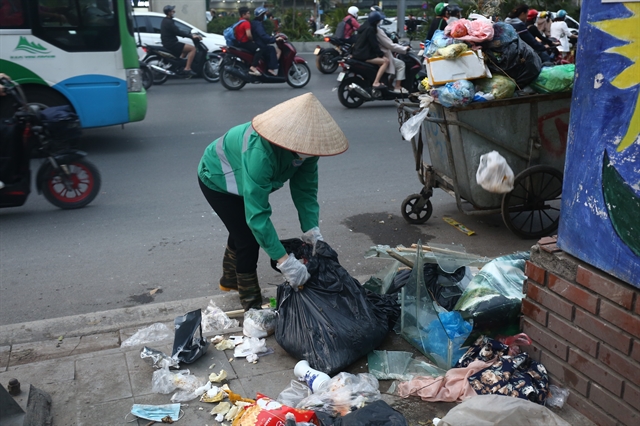 Opinion
Opinion

The Ministry of Finance has said it is considering raising value added tax (VAT) to 11 percent from 2019 and then to 12 percent by 2020 from the current 10 percent.
 |
By Thu Vân
It’s a well-worn cliché that one cannot escape death and taxes.
However, it does not mean they are accepted unquestioned.
The Ministry of Finance has said it is considering raising value added tax (VAT) to 11 percent from 2019 and then to 12 percent by 2020 from the current 10 percent. It had made the proposal last August.
The reason given was one that we’ve been hearing often of late. Việt Nam’s public debt is rising and raising VAT is in accordance with international norms, the ministry said in its draft proposal, noting that this “global trend” could be seen in many developed nations like the United States and several European countries.
The added tax will make up for shortfalls arising from Việt Nam fulfilling its commitment to cut import tariffs under several free trade agreements, and help tackle rising public debt, goes the argument.
If the proposal is approved, Việt Nam will have the second highest VAT rate in Southeast Asia after the Philippines, where goods and services are levied at 18 percent.
While the reasons given for the VAT hike are logical, other questions come into play: Will the increase have a negative impact on consumption considering the slow improvement in purchasing power witnessed in recent years? More importantly, will it have negative impact on the poor and vulnerable people?
These questions are important, for the VAT is ultimately borne by consumers, not businesses. And it has been recognized that their impact on disadvantaged sections of the society can be disproportionately hard, essentially making it a regressive measure.
The ministry insists that the nation’s VAT is quite low at present, and that increasing it will make up for revenue losses, but is this the only way? The Government should have known, when it entered into the numerous FTAs, that this would happen. Did they plan that the cost of the revenue loss should be borne by people, not businesses or, for that matter the Government itself?
To elaborate on the last point, FTAs are supposed to help businesses, but the public should make up the shortfall? And shouldn’t the government reconsider its own spending before increasing taxes on the consumer?
As tax payers, the consumer or the public have a right to know where the money is going, and whether it is being used efficiently and effectively, especially since rising public debt is part of the argument.
The State Audit Office of Việt Nam last week announced its findings: the number of redundant public servants in the State apparatus is 57,175.
While every leader is calling on State agencies to take drastic measures against the staff redundancy, what is happening on the ground does not inspire confidence that these calls are being taken very seriously.
If nearly 60,000 state employees are seen as redundant, it means that they are still being paid, which is an extra burden on the State Budget, which means the burden remains on the hapless taxpayer.
Let us examine another piece of information: we have two heads of department at the Foreign Economic Relations Department under the Ministry of Planning and Investment, and the same department has six deputy heads.
How did this happen?
The explanation given was that these officials were previously from two divisions that were merged into one, but a former high ranking official has said that this was not an isolated instance. In many other agencies, there are heads of divisions alongside others of the same rank who do not assume the corresponding jobs. Worse still, in a certain division, apart from three or four deputy directors, there are another three or four more people of the same rank.
The number of public servants per 1,000 people in Việt Nam is 43, excluding the number serving in the Ministry of Defense and Ministry of Public Security. Compare this with figures in some regional countries, inclusive of military and security personnel - just 13 in the Philippines, 16 in India, and 17 in Indonesia.
After two years implementing the Politburo’s Resolution 39 – which aimed to cut the State payroll by 70,000 each year – the total number has not dropped, but leapt by an additional 96,000. While countries around the world have between 12 and 16 ministries on average, we have as many as 22 ministries and equivalent bodies.
So there we have one painful answer to rising State Budget expenditure – an obese State apparatus in terms of its staffing.
Let’s look at another aspect of this issue.
According to a report by the Ministry of Finance, in 2017, the total accumulated losses of 17 State-owned corporations reached VNĐ12.5 trillion (US$551.2 million).
The accumulated report of four State-owned corporations in 2016 revealed that losses incurred, parent companies and subsidiaries included, had risen to VNĐ1.3 trillion (roughly US$57.5 million).
There’s more.
The Government Inspectorate has just finished an investigation of the Việt Nam Coal and Mineral Corporation, and proposed that an amount of almost VNĐ15 trillion and 6.7 million sq.m of land and housing be investigated.
Yet another moot point: how will people enjoy due social benefits from a tax increase if the money is propping up an inefficient bureaucracy? This administration has taken upon itself the task of being an effective one, and this would entail that people are not unduly taxed.
The obvious solutions have been identified and highlighted by our leaders – curb wasteful spending, streamline the State apparatus, manage the economy more effectively. This has to be the starting point.
Increasing taxes is an easy way out that does not require much imagination. Gaining the people’s trust and confidence, and then keeping it, is a harder task, but it is one that the Government has to apply itself to.
Therein lies its salvation, and ours.—VNS




